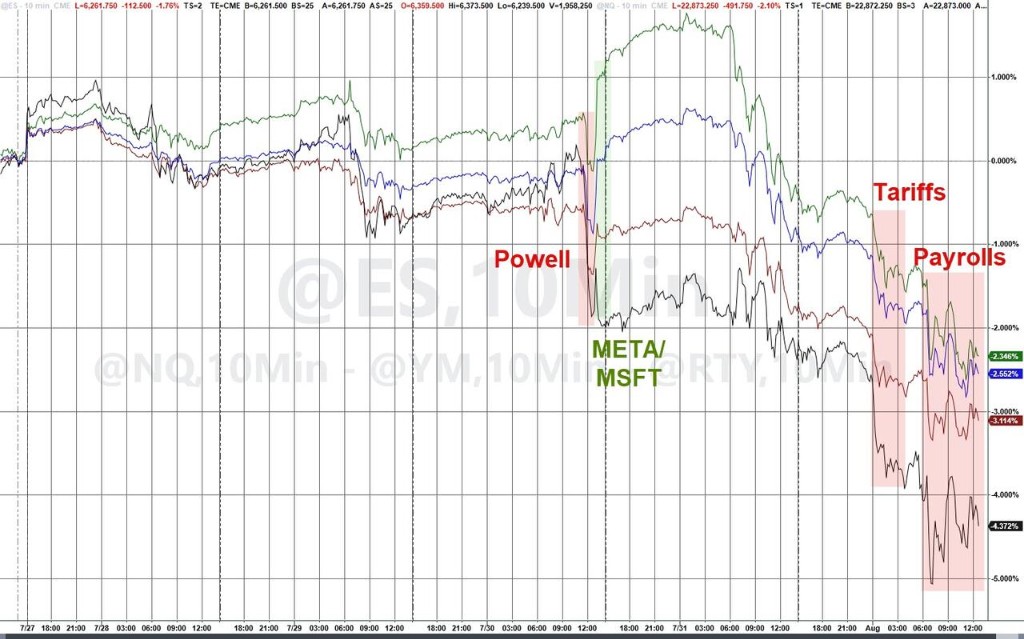
U.S. stock futures and European stocks fell collectively, the Swiss franc and New Taiwan dollar declined, and spot gold hovered below $3,300

標普錄得 5 月以來最大跌幅,小盤股受創最重,VIX 恐慌指數突破 20。亞馬遜暴跌 8% 領跌科技七巨頭。2 年期美債收益率大跌超 28 個基點、10 年期跌 16 個基點。美元下挫超 1.3%。日元升值超 2%。以太坊下跌近 6%。黃金大漲 2%,特朗普稱將派兩艘核潛艇回應俄羅斯挑釁。內盤期貨夜市普跌,焦炭跌 2.75%,低硫燃油跌 2.51%。
美國疲軟的就業數據,徹底打破了 “勞動力市場依舊強勁” 的敍事,降息預期急劇升温。與此同時,特朗普政府再推一攬子關税舉措,疊加地緣局勢驟然緊張,避險情緒高漲。標普 500 指數錄得 5 月以來最大跌幅,小盤股受創最重,VIX 恐慌指數突破 20,亞馬遜領跌科技七巨頭。
9 月降息幾乎被市場視為定局,2 年期美債收益率大跌超 28 個基點,10 年期跌 16 個基點。美元重挫,日元順勢收復本週所有跌幅。黃金大漲 70 美元,特朗普稱將派兩艘核潛艇回應俄羅斯挑釁。內盤期貨夜市普跌,焦炭、低硫燃油領跌。
以下為核心資產走勢:
美股盤前,據新華社,美國白宮 7 月 31 日晚發佈公告稱,美國總統特朗普當日簽署行政令,公佈 69 個貿易伙伴的輸美商品所適用的關税税率。據華爾街見聞,美國 7 月非農新增就業 7.3 萬遠低於預期,前兩月數據大幅下修 25.8 萬,9 月降息幾乎被市場視為定局。
美股早盤,貿易擔憂疊加美聯儲降息預期大漲,美股大幅低開,納指跌超 1%。2 年期美債收益率大跌超 28 個基點。美元重挫逾 1%,日元順勢升值,最終漲超 2%、收復本週所有跌幅。
美股盤中,華爾街見聞撰文,美國 7 月 ISM 製造業 PMI 創九個月最快萎縮,就業指標創逾五年最低。市場對美國經濟衰退的擔憂抬頭,美國 10 年期國債收益率下跌將近 15 個基點。美股跌幅擴大,納指跌 495 點跌幅 2.34%,費城半導體指數跌 3.13%,恐慌指數 VIX 漲超 29%。
內盤期貨夜市普遍收跌,焦炭跌 2.75%,低硫燃油跌 2.51%,焦煤跌 2.42%。純鹼和鐵礦石夜盤則至多收漲 0.32%。
美股盤午盤,據央視新聞,特朗普表示,為回應俄羅斯聯邦安全委員會副主席梅德韋傑夫的言論,他已下令將兩艘核潛艇部署至相應區域。華爾街見聞提及,地緣政治風險上升,原油日內跌幅一度小幅反彈,但最終依舊收跌近 3%。黃金延續非農數據後漲勢、日內大漲 2.2%。
週五美股,納指和羅素小盤股指數收跌超 2%,小盤股和銀行指數本週跌超 4%。航空業 ETF 收跌約 3.5%,和網絡股 ETF 領跌美股行業 ETF。亞馬遜市值單日蒸發超 2000 億美元。
美股基準股指:
標普 500 指數收跌 101.38 點,跌幅 1.60%,報 6238.01 點,本週累計下跌 2.36%。
道瓊斯工業平均指數收跌 542.40 點,跌幅 1.23%,報 43588.58 點,本週累跌 2.92%。
納指收跌 472.32 點,跌幅 2.24%,報 20650.13 點,本週累跌 2.17%。
納斯達克 100 指數收跌 454.81 點,跌幅 1.96%,報 22763.31 點,本週累跌 2.19%。
羅素 2000 指數收跌 2.03%,報 2166.78 點,本週累跌 4.17%。
恐慌指數 VIX 收漲 22.07%,連續第二個交易日反彈,報 20.41,本週累漲 36.70%。
美股行業 ETF:
全球航空業 ETF 收跌 3.47%,網絡股指數 ETF 跌 3.32%,可選消費 ETF 跌 2.41%,科技行業 ETF 與區域銀行 ETF 至多跌 2.16%。
(8 月 1 日 美股各行業板塊 ETF)
科技七巨頭:
美國科技股七巨頭(Magnificent 7)指數下跌 2.90%,報 179.80 點,本週累計下跌 1.38%。
亞馬遜收跌 8.27%,Meta Platforms 跌 3.03%,蘋果跌 2.50%,英偉達跌 2.33%,特斯拉跌 1.83%,微軟跌 1.76%,谷歌 A 跌 1.44%。
芯片股:
費城半導體指數收跌 1.43%,報 5527.61 點,本週累跌 2.09%。
台積電 ADR 收跌 2.65%,AMD 跌 2.64%。
中概股:
納斯達克金龍中國指數收跌 1.82%,報 7326.79 點,本週累計下跌 4.93%。
熱門中概股裏,文遠知行、B 站、理想、騰訊至少跌超 3%,拼多多、小馬智行、台積電、網易至少跌超 2%。
其他個股:
巴菲特旗下伯克希爾哈撒韋 B 類股則收漲 0.20%,禮來製藥漲 3.01%。
歐元區藍籌股指收跌 2.9%,法國公司聖戈班、安盛、施耐德電氣至多跌約 9.3% 表現最差。法國股指收跌 2.9%,意大利銀行板塊跌約 4.4%,本週丹麥股市跌約 18.4%
泛歐歐股:
歐洲 STOXX 600 指數收跌 1.89%,報 535.79 點,本週累計下跌 2.57%。
歐元區 STOXX 50 指數收跌 2.90%,報 5165.60 點,全天持續震盪下行,本週累跌 3.49%。
各國股指:
德國 DAX 30 指數收跌 2.66%,報 23425.97 點,本週累計下跌 3.27%。
法國 CAC 40 指數收跌 2.91%,報 7546.16 點,本週累跌 3.69%。
英國富時 100 指數收跌 0.70%,報 9068.58 點,本週累跌 0.57%。
(8 月 1 日 歐美主要股指表現)
板塊和個股:
歐元區藍籌股中,成分股法國聖戈班收跌 9.29%,安盛跌 7.85%,施耐德電氣跌 6.29%,意大利聯合聖保羅銀行跌 5.57%。
歐洲 STOXX 600 指數的所有成分股中,Teleperformance 收跌 20.65%,Bechtle 跌 9.58%,戴姆勒卡車跌 8.71%。
兩年期美債收益率於非農日跌超 28 個基點,交易員加大對美聯儲 9 月降息的押注。
美債:
紐約尾盤,美國 10 年期基準國債收益率下跌 16.21 個基點,刷新日低至 4.21%,本週累計下跌 17.59 個基點,整體交投於 4.4178%-4.21% 區間。
兩年期美債收益率跌 28.57 個基點,報 3.6673%,本週累跌 25.59 個基點,整體交投於 3.9591%-3.6673% 區間。
(美國主要期限國債收益率大跌)
歐債:
歐市尾盤,德國 10 年期國債收益率跌 1.6 個基點,報 2.679%,北京時間 20:30 發佈美國非農就業報告後,從日高 2.738% 附近跳水至 2.7% 下方,本週累計下跌 3.9 個基點。
英國 10 年期國債收益率跌 4.1 個基點,報 4.528%,本週累計下跌 10.8 個基點。
法國 10 年期國債收益率累跌 3.8 個基點,西班牙 10 年期國債收益率累跌 5.2 個基點。
美元指數在非農日跌 0.9%,本週仍然漲 1.4%。日元在非農日猛漲超 2.2%。以太坊大跌超 5%。
美元:
紐約尾盤,ICE 美元指數跌 0.92%,報 99.051 點,本週累計上漲 1.44%,整體交投區間為 97.492-100.257 點。
彭博美元指數跌 0.71%,報 1213.03 點,本週累漲 1.21%,整體交投區間為 1196.82-1224.64 點。
(彭博美元指數大跌)
日元:
紐約尾盤,美元兑日元下跌 2.23%,報 147.36 日元,本週累計下跌 0.21%,整體交投區間為 150.92-147.30 日元。
歐元兑日元跌 0.70%,報 170.88 日元,本週累跌 1.49%;英鎊兑日元跌 1.66%,報 195.786 日元,本週累跌 1.40%。
離岸人民幣:
紐約尾盤,美元兑離岸人民幣報 7.1938 元,較週四紐約尾盤漲 153 點,日內整體交投於 7.2241-7.1882 元區間。
加密貨幣:
紐約尾盤,現貨比特幣跌 2.72%,報 113307 美元。
(比特幣價格下挫)
以太坊跌超 5.7%,報 3518.69 美元。
國際油價非農日收跌約 2.8%,本週仍然漲超 3%。
原油:
WTI 9 月原油期貨收跌 1.93 美元,跌幅超過 2.78%,報 67.33 美元/桶,本週累計上漲 3.33%。
(WTI 原油期貨下挫)
布倫特 10 月原油期貨收跌 2.03 美元,跌幅 2.83%,報 69.67 美元/桶,本週累漲超 3.10%。
天然氣:
NYMEX 9 月天然氣期貨收跌 0.74%,報 3.0830 美元/百萬英熱單位,本週累跌超 2.37%。
現貨黃金在非農日漲 2.2%,本週整體轉漲,紐約銅累跌超 23%,鉑金跌超 6%。
黃金:
紐約尾盤,現貨黃金漲 2.20%,報 3362.15 美元/盎司,本週累計上漲 0.74%。
(現貨黃金價格大漲超 2%)
COMEX 黃金期貨 10 月合約漲 2%,報 3415.70 美元/盎司,本週累漲 0.69%。
白銀:
紐約尾盤,現貨白銀漲 0.88%,報 37.0355 美元/盎司,本週累跌 2.95%。
COMEX 白銀期貨漲 1.03%,報 37.090 美元/盎司,本週累跌 3.30%。
其他金屬:
紐約尾盤,COMEX 銅期貨漲 0.46%,報 4.4435 美元/磅,本週累跌 23.19%。
現貨鉑金漲 2.00%,報 1317.90 美元/盎司,本週累跌 6.34%;現貨鈀金漲 0.99%,報 1210.61 美元/盎司,本週累跌 1.22%。


